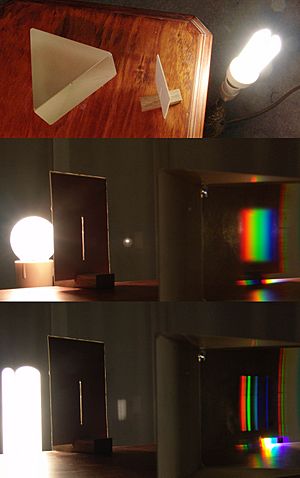Spectral line facts for kids

Spectral lines are like unique barcodes for different chemical elements. Scientists use them to figure out what things are made of, even faraway stars. These lines appear as specific colors of light that are either missing or extra when you look at a rainbow of light.
Contents
Discovering Light's Secrets
To understand spectral lines, let's first think about color. When you see a rainbow, you see all the colors of light, from purple to red. Hundreds of years ago, a famous scientist named Isaac Newton did an experiment. He showed that even white light from the Sun is actually made up of all these rainbow colors.
Later, other scientists looked at this rainbow very closely. They noticed tiny dark lines breaking up the rainbow. These lines appeared where certain colors should have been. It was like parts of the rainbow were missing! They found these lines were very small. You could only see them when the rainbow was stretched out a lot.
Scientists investigated further. They discovered that certain chemical elements, like hydrogen and helium (which make up the Sun), absorb specific colors of light. It's like a sponge soaking up water. These elements absorb the light where those dark lines appear.
Each Element's Unique Fingerprint
Soon, scientists learned more. They found that when they heated other chemical elements, like calcium or oxygen, until they glowed, they also produced lines. But these lines were in different places along the rainbow. No two elements had lines in the exact same spots.
This discovery was a huge step! Scientists realized they could use these unique patterns. They could tell what distant stars in the Universe were made of, just by looking at their light.
Why do elements have these unique patterns? It's all about tiny particles called electrons. Electrons orbit around the center of each atom. When light hits these electrons, they absorb a specific wavelength or color of light. The color they absorb depends on their position around the atom. Since every chemical element has a certain number of electrons arranged in a unique way, each element creates its own special set of spectral lines. It's like a unique fingerprint for each element!
How Red Shift Helps Astronomers
Since each set of spectral lines is unique, scientists found another amazing use for them. They use a technique called red shift. Red shift helps astronomers understand how objects in the Universe are moving.
After figuring out what a star is made of, astronomers can tell how fast it is moving away from us. They can also estimate how far away it is. This is because the spectral lines from objects moving away from us shift slightly towards the red end of the spectrum. It's a key tool for exploring our vast Universe!
See also
 In Spanish: Línea espectral para niños
In Spanish: Línea espectral para niños

